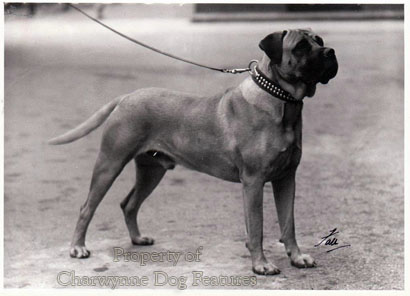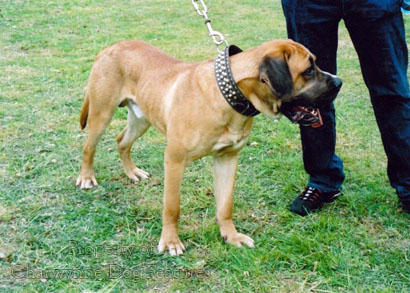202 This Noble Breed
THE CHILLINGHAM BULLMASTIFF - THIS NOBLE BREED
by David Hancock
 It was commonplace one hundred years ago to find that a particular breed of dog was patronised by one or more noble families, with the gundog breeds being especially favoured. Setters, for example, were bred by the Earl of Carlisle at Naworth Castle, Lord Wallace at Featherstone Castle, Lord Lovat at Beaufort Castle, the Earl of Southesk in Forfarshire, the Earl of Seafield at Urquhart Castle and, of course, the Duke of Gordon, who left us the breed bearing his name. Some noblemen produced their own variety like the jet black setters of Lord Ossulton of Chillingham Castle.
It was commonplace one hundred years ago to find that a particular breed of dog was patronised by one or more noble families, with the gundog breeds being especially favoured. Setters, for example, were bred by the Earl of Carlisle at Naworth Castle, Lord Wallace at Featherstone Castle, Lord Lovat at Beaufort Castle, the Earl of Southesk in Forfarshire, the Earl of Seafield at Urquhart Castle and, of course, the Duke of Gordon, who left us the breed bearing his name. Some noblemen produced their own variety like the jet black setters of Lord Ossulton of Chillingham Castle.
And now, once again, Chillingham Castle, near Alnwick in Northumberland, is witnessing the creation of a new "breed" of dog: the 'Chillingham bullmastiff'. Another stately home, Lyme Hall in Cheshire, once boasted its own variety of mastiff, with the last litter being whelped at the beginning of the first World War. Similar in appearance to the Lyme Hall "mastiffs" is the restored Danish breed, the Broholmer or Broholm mastiff, once favoured by Count Niels Frederik Sehested of Broholm Castle on the island of Funen.
The name of the 'Chillingham bullmastiffs' being created by Sir Humphry Wakefield at Chillingham Castle may have a familiar ring for those with knowledge of rare breeds of cattle, for the herd of Chillingham white cattle, roaming free on the estate, has formidable bulls. This remarkable castle has long needed formidable defences. At first a 12th century stronghold, Chillingham became a fully fortified castle in the 14th century. Occupying a strategic position as a fortress in Northumberland's bloody border feuds, it was regularly besieged and still features spine-chilling dungeons. Today it is defended by Sir Humphry's specially-bred "bullmastiffs".
The bullmastiff was of course the gamekeeper's 'night dog', a role carried out by the dogue de Bordeaux in France and the Neapolitan mastiff in Italy. It is therefore not surprising to find this breed of bullmastiff associated with the estates of the landed gentry. Count Hollander, writing in "The Kennel", March 1911 edition, refers to a Mr. Biggs of Osmaston Hall, Derby owning some wonderful specimens. He goes on to record: "On more than one occasion he has owed his life to his dogs. Osmaston Daisy and Osmaston Grip have taken more poachers between them than any other dog living." Mr. Biggs's dog Osmaston Turk came from a dam which was half bloodhound and half mastiff.
As with so many contemporary breeds of pedigree dog, bullmastiffs owe theirpresent type to the dedication and strong will of one particular breeder, S.E. Moseley of Burslem, Stoke on Trent, who, from his Farcroft kennel, did so much to stabilise the emerging breed. He kept to the blend of bulldog and mastiff blood required to produce a lighter mastiff and to breed out the misguided use of St. Bernard and Great Dane blood by some less enlightened breeders. The mastiffs and bulldogs used by such as Moseley however were very different from the representatives of those breeds appearing in today's show rings.
The pedigree bulldog of today is a sad commentary on how exaggerations in time exaggerate themselves, on how human fanciers rate their show ring prizes higher than the physical well-being of their dogs and how the Kennel Club registration of pedigree dogs produces a closed gene pool leaving honourable breeders with nowhere to go if they wish to breed a sounder dog. In past centuries we had Colonel Thornton crossing his pointers with a foxhound to obtain better game scenting and the greyhound being crossed with the bulldog by Lord Orford to strengthen its resolve. Nowadays we seem to have arrived at the stage where the pedigree (a piece of paper) is valued more highly than the dog (a dependent creature, utterly reliant on the whim of man).
But from time to time determined individuals set out to produce dogs to suit a perceived function (as Sir Humphry Wakefield is) and to reproduce a breed which has lost its historic mould. Working terrier enthusiasts are re-creating the true Sealyham, the real Bedlington and the genuine rough-haired fox terrier after decades of deterioration in those breeds. Ken Mollett of Pinner, Middlesex, has embarked on a breeding plan to restore, with commendable singlemindedness, the classic correct-size bulldog: unexaggerated, physically sound --- able to give birth naturally and able to take exercise without distress. He has used a blend of bullmastiff and Staffordshire bullterrier blood to produce the desired type and then bred back to oversize bulldogs for the more desirable breed points. I doubt if he will get any encouragement from the Kennel Club, which paradoxically was established to promote the well-being of dogs. But his is a noble venture which deserves support .
.
Sir Humphry Wakefield's breeding philosophy is founded on three fundaments: his dogs must be able to enjoy their guarding duties, with an equable temperament even under duress -- holding but not harming their prey; constant faithfulness to the family and their visitors, without resentment of the latter; and the production of dogs which look powerful and distinctive without losing their identity as individuals. His ingredients are: Staffordshire bullterrier cross bullmastiff on the tail male and Boxer cross lurcher on the dam's side. He believes that this will give him a medium-sized, strong, healthy dog. But his main criterion is the attainment of sound temperament, recognising that an uncertain temper in a bullbreed cross is simply unacceptable. Puppies are only used in his breeding programme if they are bold, welcoming, friendly and well-formed physically from their early days. It sounds to me as though the "Chillingham bullmastiffs" are worth owning.
Many modern pedigree dog owners will of course be horrified at the thought of cross-breeding-- to the amusement of lurcher men for whom function matters more than purity. Like Sir Humphry, the Princess Royal favours the lurcher and one of the bull breeds, the bullterrier. Her Majesty the Queen has produced her own crossbreed, the 'dorgi', a blend of dachshund and corgi. I find this contemporary preference for cross-bred dogs by the royal family very encouraging, and not just as a riposte for the pedigree dog snobs. Far too many pedigree breeds of dog are not well bred at the present time; some carrying inheritable defects, some displaying physical and temperamental unsoundness and others an alarming divergence from the historically correct mould for their particular breeds. 
Would the Duke of Newcastle have desired a working spaniel at Clumber Park in the last century weighing over six stones, as some modern show fanciers seem to ? Thankfully, the Princess Royal is supporting lighter sounder Clumbers which can work, as in the past did not just the Duke of Newcastle, but the Duke of Portland, the Earl Manvers, Lord Middleton, the Duke of Northumberland, Lord Derby, the Duke of Devonshire and Lord Spencer. A Clumber owned by the Earl Spencer of Althorp Park took top honours at one of the earliest dog shows. Sadly but almost predictably the soundest Clumber I have seen for thirty years turned out to be a Clumber-springer cross.
Regrettably it is rare nowadays to find noble families promoting a particular breed of dog, let alone producing one of their own making. I believe the world of dogs is a poorer place for it. Whilst it is good to see Prince Charles patronising small Russell-type terriers, a black Labrador would be a safe bet to emerge from most aristocrats' range rovers. Perhaps what we need is more imagination at the top: a Gatcombe Park spaniel, a Highgrove hunt terrier, a Sandringham springer or a Balmoral bullterrier. But the only new terrier breed in view at the moment is the Plummer terrier, developed by the writer and sportsman Brian Plummer.
Yet the toy spaniel world would be a poorer place without the King Charles and the Cavalier, the royal family in past times having brought a number of breeds to greater prominence. The Pembrokeshire Welsh corgi might well have disappeared by now but for the royal princesses favouring them some fifty years ago. Henry the Eighth retained a "Spanyell-keeper", Queen Elizabeth the First had a pack of pocket beagles and Queen Victoria was one of the first owners in Britain of the Russian fan-tailed greyhound, now known as the borzoi. King Edward VII, whilst favouring his foxterrier "Caesar" as a companion, was also interested in exotic breeds, owning a quartet of Rampur hounds and a Tibetan mastiff. Just before the Second World War, the Duke of Gloucester had a magnificent bullmastiff "Stingo", who won many prizes for him.
Against that background, I applaud the initiative of Sir Humphry Wakefield in developing his own breed of "Chillingham Bullmastiffs", as well as keeping faith with noble families of past centuries. The bullmastiff is the historically correct breed to guard ancestral estates: their formidable appearance being backed by their magnificent stature and balanced, most importantly, by quite admirable temperament. In times when thefts from rural properties are running at an all time high and raids on famous houses increasing each year, few would dispute the value of sizeable, fierce-looking guard dogs able to display both instinctive suspicion of strangers and gentleness with the family and friends of their owners. The 'gamekeepers' night dog' is being valued once again!